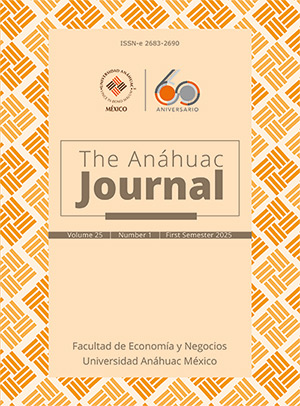Ineficiencia en los mercados automatizados de EE.UU. y México
Contenido principal del artículo
Resumen
El presente trabajo muestra un análisis de la hipótesis de los mercados eficientes (EMH), introducida por Fama (1970), que ha sido piedra angular en la teoría y la práctica en los mercados financieros por sus implicaciones para la predicción de precios futuros. La eficiencia de los mercados ha sido ampliamente explorada en la literatura, pero los avances tecnológicos recientes han hecho posible comerciar más rápido que nunca, por lo que surge una vez más la cuestión de examinar la eficiencia de los mercados de alta frecuencia, que aún no ha sido investigada en profundidad. El trabajo explora la eficiencia del mercado en varias frecuencias, desde 1 segundo hasta 10 días, en los mercados bursátiles de Estados Unidos (EE.UU.) y México. Se modeló la distribución empírica y la correlación de las series de rendimiento de los activos para tratar de evaluar si los mercados siguen un paseo aleatorio y así se puede concluir que la información se incorpora instantáneamente y el mercado es eficiente. Los resultados muestran que los mercados no son eficientes para altas frecuencias, pero por encima del umbral de 10 días las series siguen un paseo aleatorio con una distribución asintóticamente normal. La conclusión es importante tanto para los profesionales como para los académicos, ya que sugiere la posibilidad de pronosticar precios con alta frecuencia mediante la utilización de instrumentos estadísticos.
Downloads
Detalles del artículo
Sección

Esta obra está bajo una licencia internacional Creative Commons Atribución-NoComercial-CompartirIgual 4.0.
The Anáhuac Journal se distribuye bajo Licencia Creative Commons Atribución-NoComercial-CompartirIgual 4.0 Internacional.
Cómo citar
Referencias
Bessembinder, H., & K. Chan. (1998). Market Efficiency and the Returns to Tech- nical Analysis. Financial Management, 27(2): 5–17. https://www.jstor.org/sta-ble/3666289 DOI: https://doi.org/10.2307/3666289
Budish, E., Cramton, P., & Sim, J. (2015). The High-Frequency Trading Arms Race: Frequent Batch Auctions as a Market Design Response. The Quarterly Journal of Economics, 130(4), 1547–1621. https://doi.org/10.1093/qje/qjv027 DOI: https://doi.org/10.1093/qje/qjv027
Brogaard, J., Hendershott, T., & Riordan, R. (2014). High-Frequency Trading and Price Discovery. The Review of Financial Studies, 27(8), 2267–2306. https://doi.org/10.1093/rfs/hhu032 DOI: https://doi.org/10.1093/rfs/hhu032
Chen, K., & Li, X. (2006). Is Technical Analysis Useful for Stock Traders in China? Evi- dence from the SZSE Component A-Share Index. Pacific Economic Review, 11(4): 477–488. https://doi.org/10.1111/j.1468-0106.2006.00329.x DOI: https://doi.org/10.1111/j.1468-0106.2006.00329.x
Danak, D., & Patel, N. (2020). A Study of Efficiency of Index Futures, Lead-Lag Rela- tionship, and Speed of Adjustments in India Using Hgh-Frequency Data. Indian Journal of Finance, 14(4), 7–23. https://doi.org/10.17010/ijf/2020/v14i4/151705 DOI: https://doi.org/10.17010/ijf/2020/v14i4/151705
Fama, E. F. (1970). Efficient Capital Markets: A Review of Theory and Empirical Work. The Journal of Finance, 25(2), 383–417. http://dx.doi.org/10.2307/2325486 DOI: https://doi.org/10.1111/j.1540-6261.1970.tb00518.x
Fifield, S., D. Power, & D. Sinclair. (2005). An Analysis of Trading Strategies in Eleven European Stock Markets. European Journal of Finance, 11(6): 531–548. https://doi.org/10.1080/1351847042000304099 DOI: https://doi.org/10.1080/1351847042000304099
Ftiti, Z., Jawadi, F., Louhichi, W., & Madani, M. E. A. (2020). Are Oil and Gas Futures Markets Efficient? A Multifractal Analysis. Applied Economics, 53(2), 164–184. https://doi.org/10.1080/00036846.2020.1801984 DOI: https://doi.org/10.1080/00036846.2020.1801984
Gnedenko, B. V., & Kolmogorov, A. N. (1968). Limit Distributions for Sums of Independ- ent Random Variables. Addison-Wesley.
Gopikrishnan, P., Plerou, V., Nunes Amaral, L. A., Meyer, M., & Stanley, H. E. (1999). Scaling of the Distribution of Fluctuations of Financial Market Indices. Physical Review E 60(5), 5305–5316. https://doi.org/10.1103/PhysRevE.60.5305 DOI: https://doi.org/10.1103/PhysRevE.60.5305
Heng, P., Niblock, S. J., Harrison, J. L., & Hu, H. (2020). The Impact of High-Frequency Trading on Australian Futures Market Liquidity and Efficiency. Journal of Deriva- tives, 27(4), 51–76. https://doi.org/10.3905/jod.2020.1.097 DOI: https://doi.org/10.3905/jod.2020.1.097
Jarque, C. M., & Bera, A. K. (1980). Efficient Tests for Normality, Homoscedasticity and Serial Independence of Regression Residuals. Economics Letters, 6(3), 255–259. https://doi.org/10.1016/0165-1765(80)90024-5 DOI: https://doi.org/10.1016/0165-1765(80)90024-5
Karemera, D., K. Ojah & J.A. Cole. (1999). Random Walks and Market Efficiency Tests: Evidence from Emerging Equity Markets. Review of Quantitative Finance and Ac- counting, 13(2), 171–188. https://doi.org/10.1023/A:1008399910942 DOI: https://doi.org/10.1023/A:1008399910942
Koutrouvelis, I. A. (1981). An Iterative Procedure for the Estimation of the Param- eters of Stable Laws. Communications in Statistics—Simulation and Computation, 10(1), 17–28. https://doi.org/10.1080/03610918108812189 DOI: https://doi.org/10.1080/03610918108812189
Kristoufek, L., & M. Vosvrda. (2013). Measuring Capital Market Efficiency: Global and Local Correlations Structure. Physica A: Statistical Mechanics and Its Applications, 392(1): 184–193. https://doi.org/10.1016/j.physa.2012.08.003 DOI: https://doi.org/10.1016/j.physa.2012.08.003
Lahrech, A., & Sylwester, K. (2011). US and Latin American Stock Market Link- ages. Journal of International Money and Finance, 30(7), 1341–1357. https://doi.org/10.1016/j.jimonfin.2011.07.004 DOI: https://doi.org/10.1016/j.jimonfin.2011.07.004
Leone, V., & F. Kwabi. (2019). High Frequency Trading, Price Discovery and Market Ef- ficiency in the FTSE100, Economics Letters, 181, 174–177. https://doi.org/10.1016/j.econlet.2019.05.022 DOI: https://doi.org/10.1016/j.econlet.2019.05.022
Ljung, G. M., & Box, G. E. (1978). On a Measure of Lack of Fit in Time Series Models. Biometrika, 65(2), 297–303. https://doi.org/10.1093/biomet/65.2.297 DOI: https://doi.org/10.1093/biomet/65.2.297
Mensi, W., Lee, Y., Al-Yahyaee, K. H., Sensoy, A., & Yoon, S. (2019). Intraday Down- ward/Upward Multifractality and Long Memory in Bitcoin and Ethereum Markets: An Asymmetric Multifractal Detrended Fluctuation Analysis. Finance Research Let- ters, 31, 19–25. https://doi.org/10.1016/j.frl.2019.03.029 DOI: https://doi.org/10.1016/j.frl.2019.03.029
Mishra, S. (2019). Testing Martingale Hypothesis Using Variance Ratio Tests: Evidence from High-Frequency Data of NCDEX Soya Bean Futures. Global Business Review, 20(6), 1407–1422. https://doi.org/10.1177/0972150919848937 DOI: https://doi.org/10.1177/0972150919848937
Mobarek, A., A. Sabur, & R. Bhuyan. (2008). Market Efficiency in Emerging Stock Mar- ket: Evidence from Bangladesh. Journal of Emerging Market Finance, 7(1): 17–41. https://doi.org/10.1177/097265270700700102 DOI: https://doi.org/10.1177/097265270700700102
Picardo, E. (2014, June 2). Top Stocks High-Frequency Traders (HFTs) Pick (BAC,F,CSCO,INTC). HedgeChatter. Retrieved on October 26, 2020 from: https://www.hedgechatter.com/top-stocks-high-frequency-traders-hfts-pick-bacfcscointc/
Plerou, V., Gopikrishnan, P., Nunes Amaral, L. A., Meyer, M., & Stanley, H. E. (1999). Scaling of the Distribution of Price Fluctuations of Individual Companies. Physical Review E, 60(6), 6519–6529. https://doi.org/10.1103/PhysRevE.60.6519 DOI: https://doi.org/10.1103/PhysRevE.60.6519
Ratner, M., & Leal, R. P.C. (1999). Tests of Technical Trading Strategies in the Emerg- ing Equity Markets of Latin America and Asia. Journal of Banking and Finance, 23(12): 1887–1905. https://doi.org/10.1016/S0378-4266(99)00042-4 DOI: https://doi.org/10.1016/S0378-4266(99)00042-4

